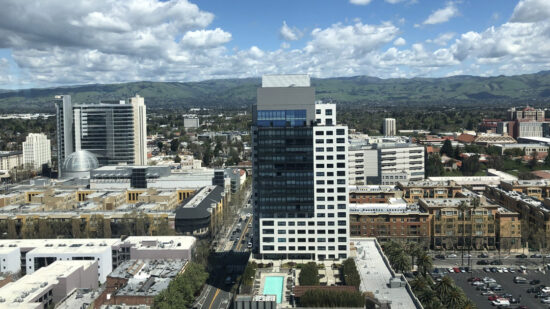
The Sixth Appellate District, on May 10, 2023, published a decision in Preservation Action Council of San Jose v. City of San Jose (2023) __ Cal.App.5th __ upholding the City of San Jose’s certification of a final supplemental EIR (SEIR) for development of three high-rise office towers in downtown San Jose on a site that contained several historic structures. The Court of Appeal affirmed the trial court’s denial of the petition for writ of mandate and held that the SEIR’s consideration of proposed compensatory mitigation for historic buildings was sufficient and that the City adequately responded to comments requesting compensatory mitigation.
Background
The project is located at the City View Plaza (originally Park Center Plaza), which was one of San Jose’s first redevelopment sites. The plaza itself and four individual buildings, including the Bank of California building built in 1971, were identified as eligible for listing on the California Register of Historic Resources and the National Register of Historic Places. The project involves demolition of all structures at City View Plaza and construction of three 19-story office towers.
The City prepared a SEIR for the project that tiered from the Downtown Strategy 2040 final EIR. During the scoping process for the draft SEIR, the Bank was identified as a candidate City landmark and the project was referred to the Historic Landmarks Commission. The commission nominated the Bank for consideration as a city landmark during the circulation period of the draft SEIR. The draft SEIR analyzed the Bank as a candidate for city landmark status and as a historic resource eligible for listing on the California and National registers.
The draft SEIR identified the proposed demolition as a significant and unavoidable impact and presented pre-demolition mitigation measures, including documenting the structures, and making them available for relocation; and mitigation measures to commemorate the site. The draft SEIR also analyzed eleven project alternatives, including six historic preservation alternatives that would have preserved different combinations of the historic structures on the site, but the City ultimately rejected them as infeasible. In June 2020, the city council decided to approve the project, certify the SEIR, and not designate the Bank as a City landmark. The City adopted a statement of overriding considerations concluding that anticipated economic, social, and other benefits of the project outweighed its significant and unavoidable impacts.
Preservation Action Council of San Jose (PAC*SJ) filed a petition for writ of mandamus challenging the project under CEQA. The trial court denied the petition and PAC*SJ appealed. On appeal, the two issues where (1) whether the City violated CEQA by not identifying, analyzing, and imposing compensatory mitigation for significant impacts to historic resources; and (2) whether the City adequately responded to comments requesting compensatory mitigation. The City also argued that PAC*SJ did not adequately exhaust both claims.
Compensatory Mitigation to Address Impacts to Historical Resources
In response to comments on the draft SEIR that proposed compensatory mitigation measures, the City responded that the measures exceeded the scope of what the City could reasonably require toward mitigation and still satisfy the proportionality and nexus predicates. Petitioner argued that the City was required to analyze proposed compensatory mitigation or make feasibility findings. The court disagreed and held that while compensatory mitigation could theoretically be used to mitigate significant impacts to historical resources, there was no statutory or other basis here to require detailed consideration of the proposed measures.
The historical significance of the City View Plaza was its specific architectural style and its association with a historical period in the City’s economic development. The draft SEIR found that no other buildings in the downtown area shared similar architectural style or historical significance. Nothing in the administrative record suggested the existence of similarly significant buildings in the downtown area that could feasibly serve as substitute resources for compensatory mitigation. The court found that compensatory mitigation would have been infeasible given the specific architectural and historical resources impact. The City, therefore, did not abuse its discretion by briefly considering and rejecting the proposed compensatory mitigation measures.
The court distinguished this case form others that have required or upheld the application of compensatory mitigation because the significant impact involved the loss of a unique, non-transferrable element of the built environment. And there was no evidence in the record that the measures could have actually mitigated the identified impact.
Response to Public Comment on Compensatory Mitigation
Petitioner also argued that the final SEIR did not adequately respond to the public comments recommending compensatory mitigation. The City countered that PAC*SJ failed to exhaust the issue because it did not raise it at the administrative level.
The court addressed the exhaustion argument first. PAC*SJ did not raise the specific issue that the City’s response to comments on the draft SEIR was inadequate. But the court held that PAC*SJ’s failure to raise the issue did not constitute a failure exhaust because the issue of adequate mitigation was raised in the administrative process.
Next, the court considered the City’s response to comments proposing compensatory mitigation in the final SEIR and held that although the responses lacked detail, they were legally sufficient. The court found that the responses, when viewed in connection with the SEIR, adequately explained the City’s reasoning for rejecting the additional mitigation measures.
Conclusion
This decision is significant because it is the only published case that addresses compensatory mitigation in the context of historic resources. It establishes that compensatory mitigation is theoretically possible to mitigate significant impacts to historical resources. However, the decision also makes clear that proposed compensatory mitigation for historical resources must involve resources with the same type of historically significant attributes as the impacted resources.
[View source.]